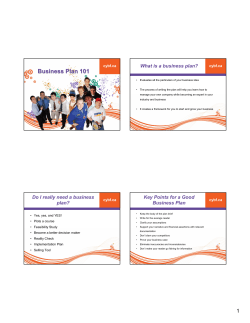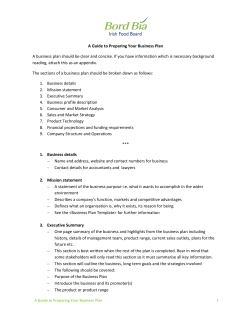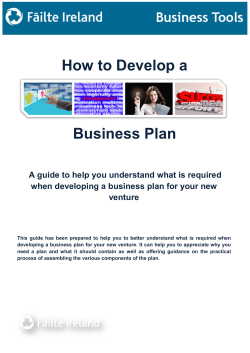
Learn Chemistry Business Skills for Chemical Scientists
Learn Chemistry Business Skills for Chemical Scientists Business Plan Template Developed by the University of Nottingham This resource was produced as part of the National HE STEM Programme www.rsc.org/learn-chemistry Registered Charity Number 207890 BUSINESS PLAN TEMPLATE COMPONENTS OF A BUSINESS PLAN 1. Executive Summary 2. Background 3. Key Personnel 4. Operations 5. Marketing 6. Financial Plan EXECUTIVE SUMMARY The purpose of an executive summary is to provide a quick and concise overview of the business (in one or two pages). Although this section appears first, it should be written last. The plan summary should highlight key elements of the entire business plan, including: - Objectives of the business (Mission Statement) Your products or services, with emphasis on distinguishing features and the market needs they will meet Your estimate of market potential and assessment of the competition Your management team's experience and talent How the products will be made or the services performed Projected financial results How much money is needed, and what will be done with it The anticipated return on investment BACKGROUND - The business you are in or plan to be in The background of your business, including when it was started, highlights of its progress Any previous financing and by whom The current ownership of your company KEY PERSONNEL - - Explain how your company's management team is organized and describe the primary role each team member plays. If appropriate, use an organization chart. Demonstrate how team members' skills complement each other. Show the balance of marketing, financial, management and production skills, as well as experience with the product or service your are developing. Key Managers: Prepare a brief synopsis of each key manager, including: - - Duties and Responsibilities Career highlights Significant past accomplishments that demonstrate ability for the tasks that will be required Include resumes in an exhibit. Resumes should include sufficient detail for future verification by a financial institution, an investor, government agency,...etc. This section should also discuss any apparent weakness in your management team. Are any critical skills missing? If so, how will this be overcome - by training? recruiting? outside advisors? Compensation & Ownership: - - State how each person will be compensated (by salary? incentive bonus? profit sharing?), and what investment each has in the company. Include a list of the stockholders and the number of shares each owns. Identify your board members (if any) and briefly discuss how each help in the development of your company. Indicate any investment board members have made in your company. OPERATIONS This section should cover items such as: - Location, capacity Costing and control Employees (numbers, union, etc.) Sources of supply Purchasing (Machinery-new or old, tools, dies, etc.) Facilities and equipment (describe the facilities and the equipment that will be required - What will these cost? Will you lease or buy? discuss future needs) - Describe the manufacturing process or the method of performing the service Discuss the labour force where you will operate - What are the costs - Is there enough labour available with the right skills? Will additional training be required? What will it cost? Is the labour force unionized or likely to be in the future? MARKETING Marketing research is the most important part of any business plan since it determines not only potential demand and the target market but also expected sales levels, future opportunities in the market, how many employees will be needed,...etc. In essence, the marketing plan is the foundation of a good business plan. This section should demonstrate that you understand how your market should be segmented, and that you have the ability to sell and deliver your product or service effectively to the right targets. This is the place to show why customers will buy from your company. The following outlines some of the things, which should be included: Market history: - Information on historical development and growth. By investigating past trends, it is often possible to anticipate future opportunities in the market. Target Market: - - Identify your target market(s). It is important to segment and target the market properly - something that new companies frequently overlook. Concentrating your resources on the needs of a specific segment and carving out a niche may mean the difference between success and failure. Facilities and equipment (describe the facilities and the equipment and equipment that will be required - What will these cost? Will you lease or buy? discuss future needs) Describe the manufacturing process or the method of performing the service Discuss the labour force where you will operate - What are the costs - Is there enough labour available with the right skills? Will additional training be required? What will it cost? Is the labour force unionized or likely to be in the future? Competition: - Investigate the competition. Understand which are direct and indirect competitors, what their pricing strategy is, their competitive advantage,...etc. If you fully understand your own strengths and weaknesses relative to your competition you are more apt to be able to turn some of your weaknesses into opportunities. Market Share: - Estimate the market share and sales volume that you think you can achieve over the next two, three years. Identify which portions of your estimate represent "hard" purchase commitments and present this information in tabular form. Pricing: - Discuss the pricing strategy and policy for your product or service. Show how your pricing approach will enable you to: penetrate the market, maintain and increase market share in a competitive environment, and make a profit. Sales Plan: - - Discuss how and where you plan to sell and distribute your product or service. Will you use a direct sales force? How many salespeople do you need? Will they be compensated by salary or by commission? What education and experience will you require, and how will you find and attract good salespeople? What degree of sales efficiency can you expect? How many sales calls will it take to get an order, and how large will an average order be? Advertising: - - Discuss how you will generate awareness of your product or service among potential customers. Which promotional activities you will use public relations, trade shows, sales incentives, promotional literature, media,...etc. Will these expenses be a large percentage of total expenses? If so, explain how much they will be and when they are likely to be incurred. FINANCIAL PLAN You will need to include financial statements and projections for the past as well as next three to five years, including: - Financial statements for the past three years of operation Cash flow projections by month for the next year Projected balance sheet and income statement for the next three years Break-even analysis Consider using a computer application to help you with projections based on your assumptions. Financial models can answer "what if" questions and show likely results under various scenarios. Your projections should be tied to your market expectations. It is important to state clearly the assumptions you used when preparing the projections. Your financial analysis should identify and support the amount of money you are seeking from potential investors or financial institutions. Preparing financial projections requires accounting and finance knowledge. If none of your team members are qualified in this area, get outside help. Money needed: This section of your plan should indicate the amount of money you will need, when you will need it, and how it will be used. Respond to questions like: - How much money do you need now? How much will you need over the next three to five years, and when? What will you do if you have underestimated the amount you will need? How will you use the initial funds? What financial structure are you proposing for the financing (i.e. what portions of the funds will be debt and equity?) What will the terms be? Do you qualify for government assistance? EXHIBITS Include exhibits to provide additional details that help tell your story. These might include: - Marketing studies Patent information Photographs or sketches of your product or service Resumes of key executives ORGANIZATION OF PLAN Organize your plan so it is easy for readers to find specific sections. Many readers will read only selected sections according to their needs for specific information. Your plan should have a table of contents. Also consider using tabs to identify major sections. OBJECTIVE REVIEW After you have completed your business plan, have others review it before sending it to potential investors or lenders. Individuals in the best position to provide you with constructive comments include business consultants, other entrepreneurs, your accounting and business advisors, and your lawyers. FINAL CONSIDERATION Your plan will contain sensitive and confidential information. Therefore, you should carefully control its distribution.
© Copyright 2025





















